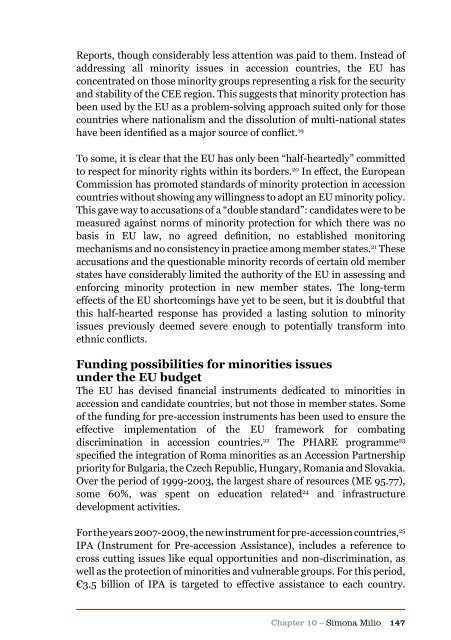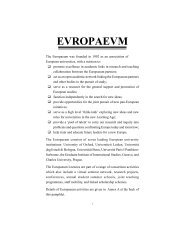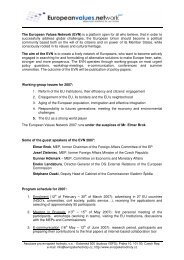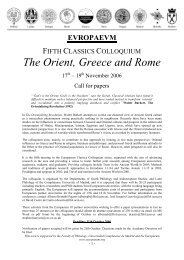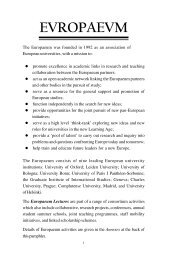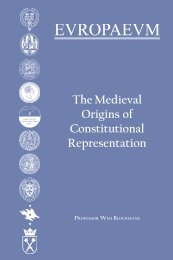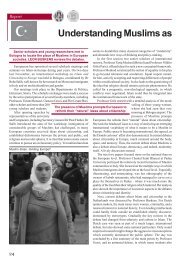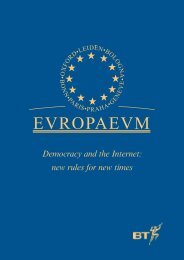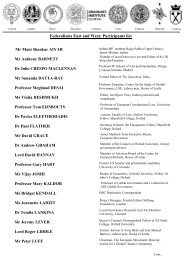Authors Iain Begg | Gabriel Glöckler | Anke Hassel ... - The Europaeum
Authors Iain Begg | Gabriel Glöckler | Anke Hassel ... - The Europaeum
Authors Iain Begg | Gabriel Glöckler | Anke Hassel ... - The Europaeum
You also want an ePaper? Increase the reach of your titles
YUMPU automatically turns print PDFs into web optimized ePapers that Google loves.
Reports, though considerably less attention was paid to them. Instead of<br />
addressing all minority issues in accession countries, the EU has<br />
concentrated on those minority groups representing a risk for the security<br />
and stability of the CEE region. This suggests that minority protection has<br />
been used by the EU as a problem-solving approach suited only for those<br />
countries where nationalism and the dissolution of multi-national states<br />
have been identified as a major source of conflict. 19<br />
To some, it is clear that the EU has only been “half-heartedly” committed<br />
to respect for minority rights within its borders. 20 In effect, the European<br />
Commission has promoted standards of minority protection in accession<br />
countries without showing any willingness to adopt an EU minority policy.<br />
This gave way to accusations of a “double standard”: candidates were to be<br />
measured against norms of minority protection for which there was no<br />
basis in EU law, no agreed definition, no established monitoring<br />
mechanisms and no consistency in practice among member states. 21 <strong>The</strong>se<br />
accusations and the questionable minority records of certain old member<br />
states have considerably limited the authority of the EU in assessing and<br />
enforcing minority protection in new member states. <strong>The</strong> long-term<br />
effects of the EU shortcomings have yet to be seen, but it is doubtful that<br />
this half-hearted response has provided a lasting solution to minority<br />
issues previously deemed severe enough to potentially transform into<br />
ethnic conflicts.<br />
Funding possibilities for minorities issues<br />
under the EU budget<br />
<strong>The</strong> EU has devised financial instruments dedicated to minorities in<br />
accession and candidate countries, but not those in member states. Some<br />
of the funding for pre-accession instruments has been used to ensure the<br />
effective implementation of the EU framework for combating<br />
discrimination in accession countries. 22 <strong>The</strong> PHARE programme 23<br />
specified the integration of Roma minorities as an Accession Partnership<br />
priority for Bulgaria, the Czech Republic, Hungary, Romania and Slovakia.<br />
Over the period of 1999-2003, the largest share of resources (ME 95.77),<br />
some 60%, was spent on education related 24 and infrastructure<br />
development activities.<br />
For the years 2007-2009, the new instrument for pre-accession countries, 25<br />
IPA (Instrument for Pre-accession Assistance), includes a reference to<br />
cross cutting issues like equal opportunities and non-discrimination, as<br />
well as the protection of minorities and vulnerable groups. For this period,<br />
€3.5 billion of IPA is targeted to effective assistance to each country.<br />
Chapter 10 – Simona Milio 147


